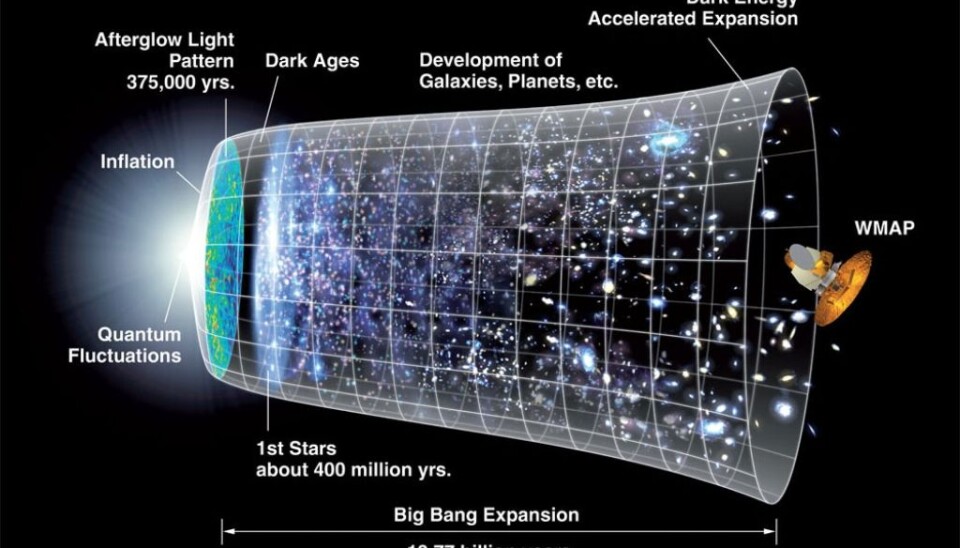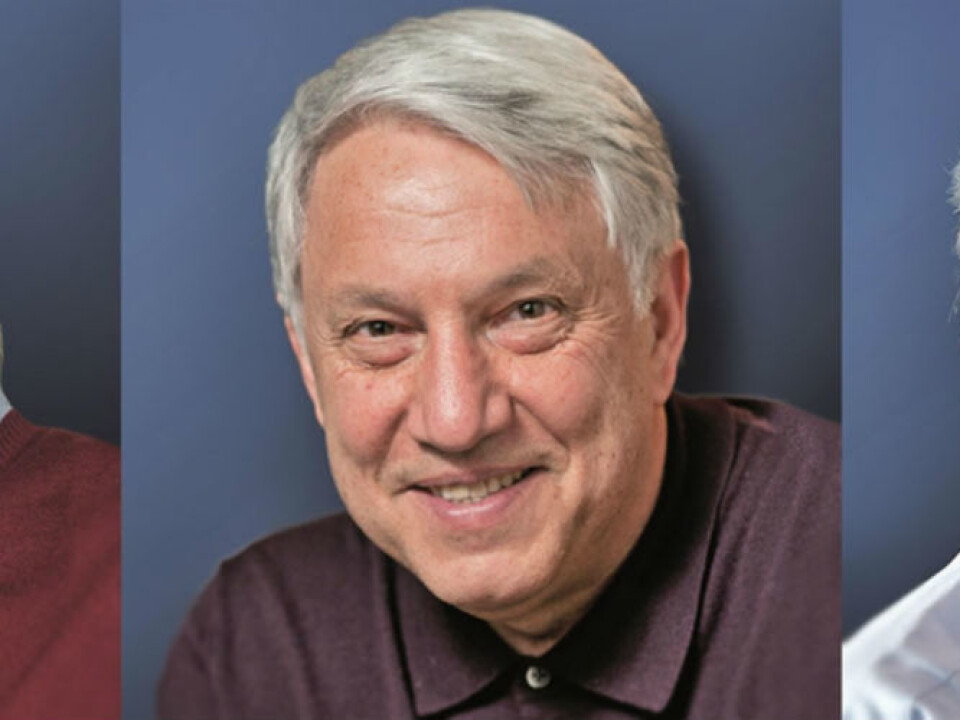
Prestigious prize for expanded universe
In its earliest moments after the Big Bang something counterintuitive happened. In much less than the wink of an eye the entire universe underwent a monstrous growth spurt, faster than the speed of light. Three physicians are now receiving the Kavli Prize for astrophysics for conceiving of this incredible cosmic inflation.
Denne artikkelen er over ti år gammel og kan inneholde utdatert informasjon.
Indeed. The entire history of the universe involves expansion.
To this day, everything is still hurling outwards at unfathomable speeds. It was the discovery of this motion, everything moving away from everything else, that led scientists to formulate the now well established Big Bang theory.
In the early 1900s, astronomers discovered that the spectral lines of light from the distant stars and galaxies was shifting on the spectrum towards red.
Edwin Hubble proposed that as the wavelengths of light were getting longer, the phenomenon called the Red Shift, that other galaxies were moving away from our Milky Way at great speed.

When something has a velocity in a given direction, you can calculate its point of departure. This and other calculations and observations have indicated that everything observable in the universe must have come from a single infinitesimally tiny spot.
Three mysteries
Nobody knows what actually triggered this Big Bang. But scientists have charted developments almost all the way back to that instant. We know it expanded incredibly fast and is still getting bigger, albeit at a lower speed.
Hold on, you might say, didn’t Einstein tell us the speed of light is an absolute maximum? How could matter hurl outwards faster than that? The answer is that light speed is an unbreakable limit within the universe, but it cannot limit the expansion of space-time itself.
But there are plenty of qualities of our universe which puzzle scientists.
Why are all the outer regions of the universe so much alike? There should be more variation.
Why does the universe appear to be flat? Everything indicates it should be curved, for instance like a bubble.
And thirdly, how come there are no magnetic mono-poles? These are theoretical magnetic particles which either have a north pole or a south pole, but not both. Physicists would expect humongous quantities of them to be formed during the beginning of the universe. Why don’t we find any?
These mysteries prodded Alexei A. Starobinsky, Alan H. Guth and Andrei D. Linde to evolve a new theory:
The hypothesis of cosmic inflation.
It says that in its first instant, the universe didn’t just expand, it blew up like crazy: All the distances became about 1,000,000,000,000,000,000,000,000,000 times greater in less than a trillionth of a second.
This inflation explains the mysteries.
Today, the notion of cosmic inflation is an essential part of the Big Bang theory. Some of the most exciting investigations in the history of the hypotheses are currently under way.
Several teams of researchers are hunting for the gravitational waves that would prove inflation really happened.
Trillionth of a second
The inflation conceived of by Guth, Linde and Starobinsky would have had an enormous impact on the development of the universe. This can explain a multitude of things, such as why the universe is so uniform and consistent.
“When we look out into space in all directions we see different areas of the universe which are extremely far apart, but they resemble one another and have roughly the same temperature,” explains Astrophysicist Jostein Riiser Kristiansen of the Oslo and Akershus University College.
And when areas are so much alike, we expect them to have had mutual contact in order to develop shared properties. Kristiansen explains what he means with an example:
“If you place a glowing clump of hot iron against a cold clump, the heat from the hot one is transferred to the cold one, and eventually they achieve equilibrium.”
But the distance between areas in the universe is too great for them to have developed characteristics in this way. So why are they alike?
This is where inflation enters the scene:
In the beginning, when the universe was very tiny, characteristics were exchanged which made for homogeneity.
“When inflation occurred, the universe expanded so fast that diverse areas that had been in equilibrium were thrown extremely far from one another. Indeed, so far that today it would seem impossible for them to have ever been in contact – had it not been for inflation,” says Kristiansen.
Curved universe
This exponential expansion can explain the mystery of the seemingly flat universe.
Researchers have conducted measurements of space to see whether in curves, for instance like the surface of a balloon.
Such a curvature would mean that the universe is not infinitely large. It is finite and closed – if you could travel far enough in a given direction you would eventually return to where you started.
Physics certainly indicates that space-time should be curved because we know that the curvature increases as time passes. Just the slightest tendency toward curvature, a slight disturbance or anomaly, in the beginning would give us the huge effect we experience today. So for the universe to be flat today the “settings” would have had to be improbably accurate from the first instant.
But here’s the rub: Measurements indicate that we do live in a flat universe.
Inflation can solve that mindblower.
Thanks to inflation, the universe has become inconceivably large in its estimated 13.8 billion years of existence – much larger than it would have been elsewise. This means that there are unfathomably huge areas outside the visible or observable universe.
You can think of the visible universe that we can detect with our most powerful telescopes as a tiny part of the surface of a colossal balloon. The balloon could be thousands, millions or billions of times larger than what we can observe. From our tiny observation range, like that of bacteria on the balloon, we wouldn’t be able to detect any curvature.
“When we make our measurements, it looks like space is flat, just like a person can experience the surface of the Earth as flat, even though it actually is curved,” explains Kristiansen.
Uncharted regions
As to what is out there in these vast, uncharted outer reaches of space that are beyond science’s circle of light, Kristiansen refers to inflation once again:
Probably the universe is the same in all directions and like the areas we know, with galaxies and stars. Black holes and dark matter and the rest.
“We have no indications that it’s any different.”
“If we discover more about inflation we might be able to explain this better, for instance how enormous the universe really is and how fast it expanded during inflation,” says Kristansen.
“It is also fabulously exciting to try and fathom exactly which physical processes came into play during inflation.”
“We are talking about physics that occurred with energies that are about 10,000 billion times higher than what we could produce at CERN, so inflation can be a vital window into fundamental physics in a completely different league than we’ve been able to observe.”
On the other hand, we will never be able to study the unknown parts of the universe directly, as they are by definition beyond anything observable. No information gets past this horizon to our regions of space.
But if we could see this entire cosmos, we might come across the vanished monopole particles which nobody has been able to detect.
Inflation has made the universe so colossal that it’s not surprising for these particles to have eluded us.
Sure, gazillions were formed during the Big Bang. But if you spread them out through space they become so far apart as to have for all purposes disappeared.
“There would only be a small portion of them in the observable universe. The odds of a monopole passing through your laboratory are infinitesimal.”
That’s how inflation solves this mystery as well.
Still unproved
We can appreciate why the inflation hypothesis has gained such a central position in modern cosmology and scientific views on how the universe started out. But it still remains to be proven.
While Peter Higgs and François Englert received their Nobel Prize after finding the long-sought elementary particle – the Higgs boson – Guth, Linde and Starobinsky won their Kavli Prize for their work to find proof of the inflation theory.
If such a gigantic expansion occurred, scientists think it should have left traces in the form of gravitational waves. These are not beyond the information horizon – they should be observable.
In March, a research team using the instrument BICEP2 announced that they thought they had observed such signals. But their results have not been verified by others and a few weeks ago rumours started up that their results were caused by a mistake.
But in November we can be expecting results from a more comprehensive study, made with the assistance of the Planck Satellite.
These could spread new light on the Kavli laureates’ hypothesis.
We could get the first real confirmation that inflation really occurred and further testimony to how essential the three scientists’ ideas have been to our comprehension of the universe.
Or the hunt will just have to continue.
Even a negative result from the Planck Satellite is unlikely to immediately knock down an established and respected hypothesis as that of cosmic inflation.
But what makes science and physics different from, for instance religions and metaphysics, is that facts that puncture theories are always welcomed.
Translated by: Glenn Ostling































